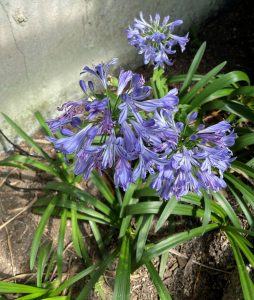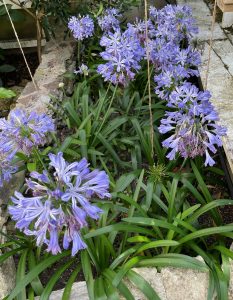Agapanthus is a genus of perennial plants known for their large, spherical clusters of flowers that bloom well above the foliage on long stems up to two feet above the leaves. The flower color ranges through all shades of blue to a creamy white. At least 20 flowers, and often a great many more, make up each large cluster, with the individual flowers resembling tiny lilies. This resemblance may be why Agapanthus was once mistakenly classified as part of the lily family and given the common name Lily of the Nile. But this plant is neither a lily nor native to the Nile region. It actually originates from southern Africa and was first brought to Europe by early explorers.

In many ways, Agapanthus is an ideal plant for the greenhouse in areas below Hardiness Zone 9, where winters are generally too cold for it to survive in an outdoor garden. Although some varieties of Agapanthus are deciduous, losing their foliage in winter, many others have long, flat, arching leaves that remain a glossy evergreen, rather like Clivia leaves. These varieties can make excellent houseplants.
When cultivated in pots, Agapanthus has definite preferences. Somewhat surprisingly, it does especially well if moderately root-bound, a condition that tends to encourage blooms. Some fertilization is also needed to keep blooms coming, but not so much that the plant becomes lanky. In my greenhouse, I’ve found that moderate monthly fertilization can keep my Agapanthus in bloom well into November. Other conditions that Agapanthus likes include bright light and regular watering, although never so much that the plant becomes water-logged. When the active growing phase is over for the year, watering can be tapered off so that the plant has just enough to remain moist during winter. As growth starts again in spring, increase the frequency of watering until bloom spikes appear and then resume fertilizing with an all-purpose fertilizer. Be sure, too, to snip off blooms as they die so that the plant doesn’t put energy into seed production. Although potted Agapanthus plants enjoy a sunny outdoor patio during northern summers, they must be brought into the greenhouse before the first frost.

In northern climates Agapanthus can also be planted in garden beds for summer and then transferred to greenhouse pots as autumn arrives. In the garden, the large, spherical clusters of flowers can add much interest, especially when mixed with other colors, such as bright yellows or reds. These plants grow from rhizomes, which are underground stems that produce both roots and shoots from nodes, so take appropriate care when digging them up.
Rhizomes, of course, can be divided to create more plants. I began with only four Agapanthus plants about ten years ago, transferring them between greenhouse pots and outdoor beds depending on the season. In the process, I routinely divided up the rhizomes. Now I have about forty plants, so many that it’s become a chore to replant them outdoors each spring. Some plants I just keep in pots to decorate my patio.
I have tried leaving plants outdoors to see if they can survive the winter under a thick pile of mulch in a 6a Hardiness Zone. They can’t! This kind of experimentation is part of the fun of gardening. You never know what new things you may discover.


